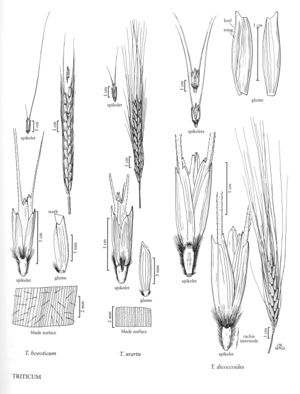Difference between revisions of "Triticum boeoticum"
(fix 'and Christine Roberts') |
imported>Volume Importer |
||
| Line 42: | Line 42: | ||
|publication year= | |publication year= | ||
|special status= | |special status= | ||
| − | |source xml=https://bitbucket.org/aafc-mbb/fna-data-curation/src/ | + | |source xml=https://bitbucket.org/aafc-mbb/fna-data-curation/src/200273ad09963decb8fc72550212de541d86569d/coarse_grained_fna_xml/V24/V24_384.xml |
|subfamily=Poaceae subfam. Pooideae | |subfamily=Poaceae subfam. Pooideae | ||
|tribe=Poaceae tribe Triticeae | |tribe=Poaceae tribe Triticeae | ||
Latest revision as of 16:23, 11 May 2021
Culms to 160 cm, decumbent at the base; nodes pubescent; internodes mostly hollow, solid for 1 cm below the spike. Blades 5-15 mm wide, blue-green, hirsute, with long hairs over the veins, shorter hairs between the veins, hairs stiff. Spikes 5-14 cm, wider than thick; rachises densely ciliate at the nodes and margins; internodes 3-5 mm; disarticulation spon¬taneous, dispersal units wedge-shaped. Spikelets 12-17 mm, rectangular, with 2-3 florets, 1-2 seed-forming. Glumes 6-11 mm, coriaceous, tightly appressed to the lower florets, 2-keeled, with 2 prominent teeth; lemmas 10-14 mm, first (and sometimes the second) lemma awned, awns to 11 cm, third lemma usually unawned; paleas splitting at maturity; anthers 3-6 mm. Caryopses of the lowest floret in each spikelet usually blue, that of the second amber or red with blue mottling; endosperm flinty. Haplome Ab. 2n = 14.
Discussion
Triticum boeoticum is a wild diploid wheat that is native from the Balkans through the Caucasus to Iran and Afghanistan and south to Iraq. It is morph¬ologically similar to and, in its native range, sometimes sympatric with T. urartu, another wild diploid wheat. Triticum monococcum is the domesticated derivative of T. boeoticum.
Boissier published the combination for this species both as "Triticum baeoticum" and "T. boeoticum". Because the type specimen is from Boeotia [Greece], "boeoticum" is the correct spelling of the epithet.
Selected References
None.
